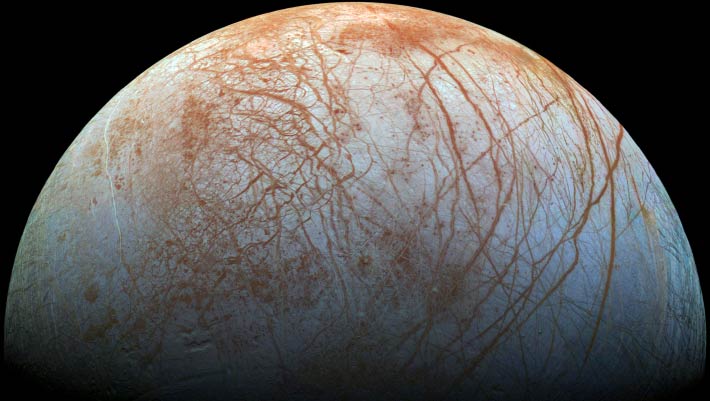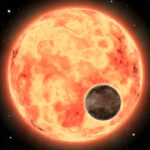Europa and Enceladus are key targets to search for evidence of alien life in our Solar System. However, the surface and shallow subsurface of these airless icy moons are constantly bombarded by ionizing radiation that could degrade chemical biosignatures. Therefore, sampling of icy surfaces in future life detection missions to Europa and Enceladus requires a clear understanding of the necessary ice depth where unaltered organic biomolecules might be present. A team of scientists from NASA and the Pennsylvania State University has conducted experiments by exposing individual biological and abiotic amino acids in ices to gamma radiation to simulate conditions on these icy worlds.
The surface of Europa looms large in this newly-reprocessed color view; image scale is 1.6 km per pixel; north on Europa is at right. Image credit: NASA / JPL-Caltech / SETI Institute.
“Based on our experiments, the ‘safe’ sampling depth for amino acids on Europa is almost 20 cm (8 inches) at high latitudes of the trailing hemisphere (hemisphere opposite to the direction of Europa’s motion around Jupiter) in the area where the surface hasn’t been disturbed much by meteorite impacts,” said Dr. Alexander Pavlov, a researcher at NASA’s Goddard Space Flight Center.
“Subsurface sampling is not required for the detection of amino acids on Enceladus — these molecules will survive radiolysis (breakdown by radiation) at any location on the Enceladus surface less than a few millimeters (a tenth of an inch) from the surface.”
Dr. Pavlov and his colleagues used amino acids in radiolysis experiments as possible representatives of biomolecules on icy moons.
Amino acids can be created by life or by non-biological chemistry.
However, finding certain kinds of amino acids on Europa or Enceladus would be a potential sign of life because they are used by terrestrial life as a component to build proteins.
Proteins are essential to life as they are used to make enzymes which speed up or regulate chemical reactions and to make structures.
Amino acids and other compounds from subsurface oceans could be brought to the surface by geyser activity or the slow churning motion of the ice crust.
To evaluate the survival of amino acids on these worlds, the researchers mixed samples of amino acids with ice chilled to about minus 196 Celsius (minus 321 Fahrenheit) in sealed, airless vials and bombarded them with gamma-rays, a type of high-energy light, at various doses.
Since the oceans might host microscopic life, they also tested the survival of amino acids in dead bacteria in ice.
Finally, they tested samples of amino acids in ice mixed with silicate dust to consider the potential mixing of material from meteorites or the interior with surface ice.
The experiments provided pivotal data to determine the rates at which amino acids break down, called radiolysis constants.
With these, the scientists used the age of the ice surface and the radiation environment at Europa and Enceladus to calculate the drilling depth and locations where 10% of the amino acids would survive radiolytic destruction.
Although experiments to test the survival of amino acids in ice have been done before, this is the first to use lower radiation doses that don’t completely break apart the amino acids, since just altering or degrading them is enough to make it impossible to determine if they are potential signs of life.
This is also the first experiment using Europa/Enceladus conditions to evaluate the survival of these compounds in microorganisms and the first to test the survival of amino acids mixed with dust.
The scientists found that amino acids degraded faster when mixed with dust but slower when coming from microorganisms.
“Slow rates of amino acid destruction in biological samples under Europa and Enceladus-like surface conditions bolster the case for future life-detection measurements by Europa and Enceladus lander missions,” Dr. Pavlov said.
“Our results indicate that the rates of potential organic biomolecules’ degradation in silica-rich regions on both Europa and Enceladus are higher than in pure ice and, thus, possible future missions to Europa and Enceladus should be cautious in sampling silica-rich locations on both icy moons.”
“A potential explanation for why amino acids survived longer in bacteria involves the ways ionizing radiation changes molecules — directly by breaking their chemical bonds or indirectly by creating reactive compounds nearby which then alter or break down the molecule of interest.”
“It’s possible that bacterial cellular material protected amino acids from the reactive compounds produced by the radiation.”
The team’s paper was published in the journal Astrobiology.
_____
Alexander A. Pavlov et al. 2024. Radiolytic Effects on Biological and Abiotic Amino Acids in Shallow Subsurface Ices on Europa and Enceladus. Astrobiology 24 (7); doi: 10.1089/ast.2023.0120
This article was adapted from an original release by NASA.



